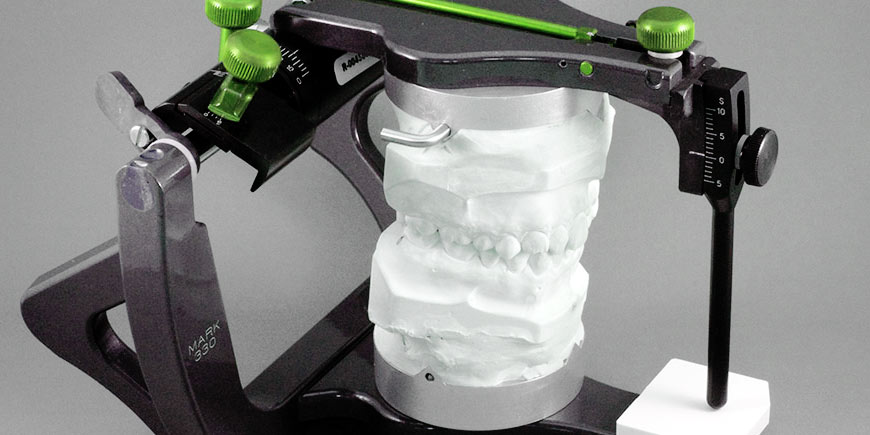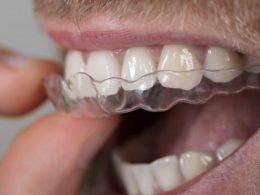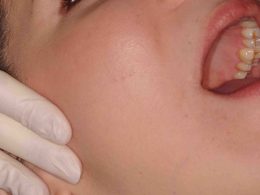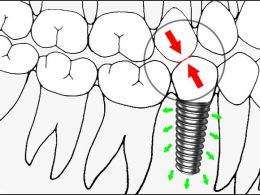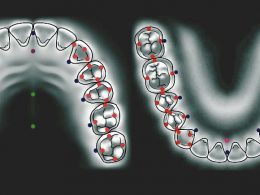Table of Contents
The articulator or occluder is a mechanical appliance with which we can relate the molds of the dental arches of the patients to be able to carry out diagnostic and therapeutic procedures outside the mouth, and that uses special devices called facial arches to transfer the maxillary model to the articulator in the same relationship to that of the skull (mounting of the models).
The articulator is an essential instrument to perform certain procedures, although some treatments can be performed without it. These instruments arose from the need to be able to imitate the mandibular movements outside the patient’s mouth and to be able to work with greater precision.
With the adjustable and semi-adjustable articulators, we try to mimic the basic movements of the mandible such as the opening and closing movement, the protrusion movement and the lateral movements. The articulator is simply a simulator of masticatory function.
Its use is essential to make any type of prosthesis and to diagnose and treat occlusion disorders. Used with skill, it ensures correct interdigitation of the teeth and an anatomically correct bite plane at the end of treatment. This implies the need for fewer occlusal adjustments before and after placing the restorations and a better functional balance between the teeth and the temporomandibular joints.
Utilities of the Articulator
The dental articulator can be useful in many aspects of Dentistry. Together with good diagnostic models and precise mounting, it can be used in diagnosis, planning of many treatments and during the execution of the same.
1- In Diagnosis
Occlusal therapy comprises two important phases: diagnosis and treatment. Because the diagnosis always precedes and dictates the treatment plan, it must be complete and accurate. Developing a treatment plan based on an inaccurate diagnosis will undoubtedly lead to treatment failure.
Establishing an accurate diagnosis is often difficult due to the complex interrelationships between the multiple structures of the masticatory system. To arrive at a reliable diagnosis, it is essential that as much information as possible is collected and analyzed. To do this, the diagnostic casts must be precisely mounted on an articulator and thus be able to understand the occlusal condition of the patient.
Mounted diagnostic models offer two main advantages in diagnosis. First, they improve the visualization of both the static and functional interrelationships of the teeth. This is especially helpful in the region of the second molar, where the soft tissues of the cheek and tongue often impede good visibility. They also allow lingual examination of the patient’s occlusion, which is impossible to appreciate clinically. This is often essential to examine static and dynamic functional relationships between teeth.
The second advantage of mounting the diagnostic casts involves the simulation of mandibular movement. In the articulator, the patient’s mandibular movements and the resulting occlusal contacts can be observed, without the influence of the neuromuscular system.
Often when a patient is examined clinically, the protective reflexes of the neuromuscular system prevent harmful contacts. As a result, interference and premature contacts can go undetected and therefore go undiagnosed. When the diagnostic casts are occluded in the articulator, these contacts become apparent. Therefore, articulated casts can aid in a more complete and accurate occlusal examination.
Articulated diagnostic casts are also often helpful in illustrating the patient. In general, people understand problems in their mouth more easily if they can visualize them directly, even through an appliance and a replica of their teeth.
2- In Treatment Planning
To properly plan a treatment, it is essential to visualize, before starting it, both the final results and each of the steps necessary to achieve them.
Diagnostic models are used to ensure successful treatment and can be used in various ways depending on the treatment being contemplated:
Selective Grinding
It is often difficult to examine a patient clinically and determine if he is a good candidate for a selective grinding procedure without damaging his teeth. If the decision is made first-time or hastily, the patient may then undergo an unplanned restorative procedure. In patients in whom it is difficult to predict the success of selective wear, the procedure is planned with properly mounted diagnostic casts and the final results are visualized.
When a large amount of tooth structure must be removed to meet treatment goals, the patient should be informed in advance that additional treatment (onlays, crowns, bridges, or orthodontics) may be necessary, which of course allows allowance for additional expenses. This type of planning with the articulator generates the confidence of the patient instead of causing surprises, doubts and discomfort.
Functional Diagnostic Wax-Up
Diagnostic waxing is the process of converting a programmed treatment plan into a three-dimensional visualization.
Functional wax-up is a method of determining optimal occlusion, and is done with the help of the articulator. This can be useful in determining the design of the preparations, the type of restorations to be fabricated, the need for orthodontics, the optimal location of restorative pontics and occlusal margins, and the need for the specific occlusal adjustment procedure.
This allows us to develop an adequate treatment plan and proceed effectively towards success, taking into account that our final result has to be predictable at every stage of treatment.
Waxing is essentially a prototype of the treatment and consists of modeling future restorations in wax before they are made. In this way, we will be able to determine how they will look from an aesthetic point of view and how they will function during chewing. In addition, the wax-up will allow us to determine if the treatment we have in mind is the most appropriate or if it needs some modifications.
Esthetic Waxing
It is very discouraging when time and money have been invested in the fabrication of anterior crowns or a fixed prosthesis and then the patient is not satisfied with the cosmetic results. Pre-existing conditions must be carefully examined in order to determine the effects they will have on the final esthetics of a restoration.
Unusual interdental spacing, tissue morphology, or occlusion often alter the final appearance of a crown or fixed prosthesis. If the final esthetics cannot be visualized due to unusual pre-existing conditions, a dental esthetic wax-up done on the articulator will always be indicated.
This allows to obtain a visualization of the most favorable results, from the aesthetic point of view, that can be achieved; and gives the professional and the patient an idea of what to expect once the final treatment is completed.
If during waxing it becomes evident that the aesthetic results will not be satisfactory, we will be in time to resort to other complementary treatments such as dental implants, orthodontics, periodontics, endodontics, or even; removable partial dentures.
The main benefit of cosmetic waxing is that it makes patient expectations realistic, minimizing any chance of postoperative disappointment. Thus, the treatment can begin with a greater guarantee of success.
Diagnosis in Orthodontics
The misalignment of the dental arches is generally treated more appropriately with orthodontics. In simple and routine cases, orthodontic results can be easily predicted. However, sometimes a particular alignment problem or crowding of the teeth can make it difficult to visualize the final results.
When this circumstance exists, mounted diagnostic casts are very helpful. The teeth can be sectioned from the models and repositioned in wax so that the Orthodontist and the patient can visualize the expected final result. This also provides the practitioner with an idea of unexpected problems that may arise during orthodontic therapy.
When considering the extraction of permanent teeth, the pieces to be extracted are left out of the configuration. Thus, the orthodontic results that will be achieved through extractions can be compared with the results that we would obtain without them. The most appropriate treatment is selected by viewing the final results of the different available treatments.
Therefore, an articulator and orthodontic mounting provide valuable information for treatment planning, especially in the most complex or difficult cases.
Design of Prosthesis and Oral Rehabilitations
The specific design of a fixed or removable prosthesis generally depends on the functional and aesthetic considerations of the mouth. Articulator-mounted diagnostic casts are helpful in designing restorations that best suit these requirements. Occlusal requirements, whether for a single crown or for a complete rehabilitation, can be visualized and predicted through articulated casts.
When a tooth is weakened by caries or a pre-existing restoration, a treatment capable of strengthening and preserving the clinical crown should be selected, but always trying to be as conservative as possible. Articulator mounting is very helpful when deciding between onlays and full cover crowns, just to give one example.
Occlusal analysis of the casts may reveal areas that need additional support for occlusal forces, as well as areas where aesthetics may be the primary consideration. In this way, the restoration will be designed to meet both aesthetic and functional needs. The same occurs in cases where the main objective is the placement of dental implants.
The articulator should even be used to design removable partial dentures. The articulated diagnostic models provide information on the space available between the dental arches for the base of the prosthesis, as well as which teeth are best positioned for the clasps and occlusal and incisal supports.
3- In the Treatment Properly Said
Probably the most common use of the dental articulator is in treatment. The articulator cannot treat a patient, but it can be an indispensable aid in the creation of prosthetic structures that will aid his rehabilitation.
It can provide the information needed regarding jaw movement in order to design a prosthesis or rehabilitation that is as biocompatible as possible. Although in theory this information could be gathered by working directly on the mouth, the articulator suppresses many factors that lead to error such as the tongue, cheeks, saliva and the neuromuscular control system.
In addition, in some cases it is convenient to use materials that are not suitable for the oral cavity, and dental replicas facilitate their use. Similarly, direct vision of all teeth from all angles and profiles while the patient occludes, is something that can only be achieved with the use of these simulators.
Prosthodontics, Surgery and Orthodontics are the Specialties that benefit the most from the use of these wonderful devices.
“The Use of Dental Articulators Is Essential in an Ethical, Serious and Responsible Clinical Practice”.
DENTAL TIP
The Smile of Your Dreams Awaits You in Venezuela!
A cost saving alternative to your local dental care.
DENTAL VIP offers dental services in Caracas to patients from North America, Europe and the Caribbean.
We designed all our services to meet the special needs and expectations of our guests travelling for treatment:
- 50-70% lower prices.
- Volume discounts.
- Free consultation (X-ray, dental quote and transport).
- Extended guarantee packages for all treatments.
- Shorter treatment times and no waiting list.
- Free all time patient support.
- Travel and hotel assistance.
- After-care services.
We wish to ensure that your visit not only saves you money but you receive the best care for your dental needs. DENTAL VIP is dedicated to provide value for your money in your dental treatment, travel, and stay in Caracas.
Do not compromise on quality for the price, visit us in Caracas for your treatment and allow yourself the best. Do not settle for awkward removable dentures, low-end dental implants, or only temporary solutions.
Do not waste any more time, contact us right now!






